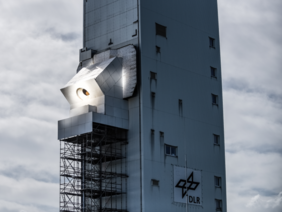Last several years scientists at the German Aerospace Center (Deutsches ZentrumfürLuft-und Raumfahrt; DLR) have carried out experiments to research the technological possibilities of the high-temperature centrifugal solar receiver CentRec they developed. The centrifugal receiver CentRec, as designed by the research institute, consists of a rotating chamber which is fixed to a solar tower and faces towards a field of solar heliostats which are adjusted so that they reflect the sunlight onto the receiver. Inside the top of the chamber is a device for the introduction of small aluminium-ceramic particles of around one millimetre in size. When the chamber is rotating the centrifugal force causes the particles to be pressed to the interior wall of the chamber and the particles are heated to a very high temperature. With the help of the force of gravity the hot particles fall out of the chamber, at the particle outlet are collected in special thermally insulated containers and can be used in various technological processes, such as steam production at power stations or heat storage. Particle temperature can be controlled, either by regulating the concentration of the solar radiation reflected by the heliostats or the rotation speed of the chamber. This device constitutes a comprehensive system for heat transfer and heat storage which is inexpensive and easy to maintain. Applications have been registered for this technology in various patent offices, in particular SOLAR-RADIATION RECEIVER, AND METHOD FOR THE SOLAR HEATING OF HEAT TRANSFER MEDIUM/ A: EP2646758A2 / IPC: F24J2/07, F24J2/46 / BUCK REINER, AMSBECK LARS, ROEGER MARC, GOBEREIT BIRGIT, WU WEI / DEUTSCH ZENTR LUFT & RAUMFAHRT / Appl. date: 30.11.2011; Publ. date: 09.10.2013/ European Patent Organisation (EPO)
In 2013 researchers mounted a test device on the solar tower of the Jülich Solar Power Station, and tests with artificial sunlight were conducted on the system which yielded promising results. Throughout 2017, the first field experiments with concentrated solar radiation were carried out on CentRec at the solar-thermal power station of the German Aerospace Center. At the Jülich Solar Tower the ceramic particles which had been introduced into the receiver were heated up to 900°C. Measuring devices showed record temperatures of 775°C when the particles fell out of the receptacle.
Finally, in May 2018 a unique experiment was carried out at the Jülich Solar Tower where the particles in the receiver were heated to more than 965°C, thus demonstrating the high potential of concentrated solar energy and the effectiveness of the new receiver.
The advantages of the CentRec receiver construction are clear: firstly, increasing the temperature of the receiver can also boost the efficiency of solar power stations; secondly, the device can improve energy storage systems, which ensure that solar power stations work properly, even when solar irradiation levels are low, e.g. at night; Thirdly, its design can effectively reduce the costs of the receiver.
Contemporary energy storage systems employed at solar power stations use liquid salts that only work at temperatures up to approximately 550°C - 565°C, and the temperature of the steam which enters the turbine is even lower. The system discussed in this report, on the other hand, can produce steam temperatures of up to 620°C. During downtime of the system power stations that use molten salts need to have an emergency heating system in place to avoid the liquid salts from freezing. Also, as the molten salts are not heated directly by solar radiation but by means of additional metal tubes, efficiency losses in the thermal process as well as further costs are incurred. The bauxite particles used in this design possess unique characteristics, such as thermal conductivity, thermal activity, easy availability and low cost. They are also environmentally safe.
The scientists involved in the development of this device claim that it can also be used in other industrial fields, such as metallurgy.
The tests conducted on the device open up new perspectives for its commercial use, which may increase the competitiveness of solar power stations with solar concentrators. Advanced Energy Technologies will closely follow the latest developments in this field.
